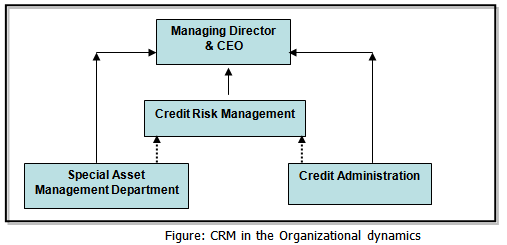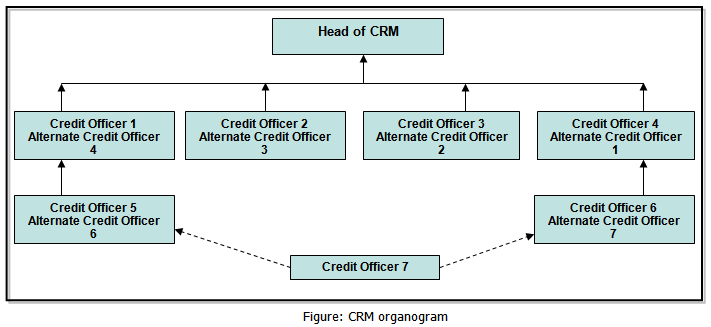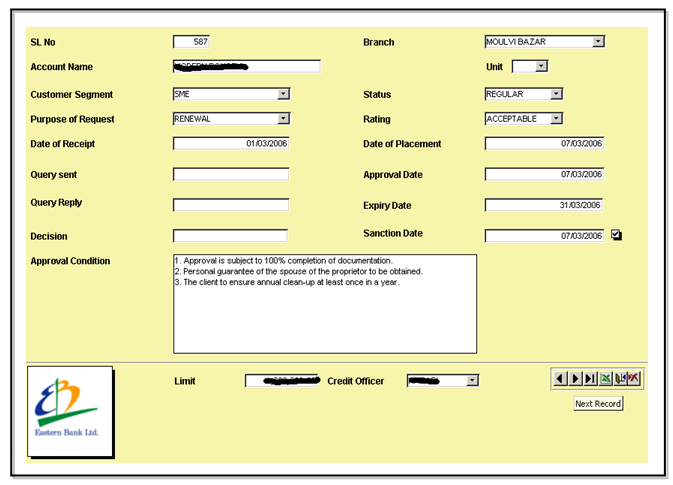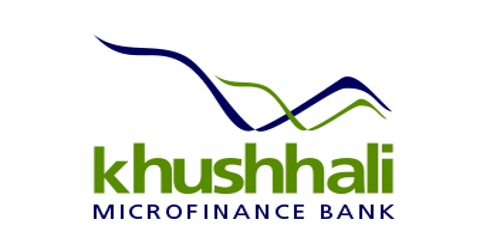INTRODUCTION:
Credit Risk Management is one of the most crucial components of the dynamics of bank management as credit lending is the principal activity for the commercial banks. In this segment of the report Credit Risk management practice of Eastern Bank Limited will be thoroughly discussed and then it will be compared and contrasted with Prudential Guidelines of Bangladesh Bank. Then two of the key credit management practices: Handling of Non-performing loans and procedures for loan classification will be discussed simultaneously.
Risk is inherent in all aspects of a commercial operation; however for banks and financial institutions, credit risk is an essential factor that needs to be managed. Credit risk is the possibility that a borrower or counter party will fail to meet its obligations in accordance with agreed terms. Credit risk, therefore, arises from the bank’s dealings with or lending to corporate, individuals and other banks or financial institutions.
Eastern Bank Limited has categorized its credit risks into four broad categories for its risk management purpose. Each class of risk has their unique management technique. Following are the four broad categories of risks defined internally by the bank:
Class- A
Class- B
Class- C
Class- D
CLASS – A:
Credit facilities extended to clients which are secured by:
- 100% cash covered by having the funds available in EBL’s cash margin account
- 100% EBL Fixed Deposits fully liened & pledged in favour of the Bank
- 100% in the form of Govt. Sanchya Patra fully liened & pledged in favour of the Bank
- 110% cash covered if credit facilities are in different currency than that of collateral
CLASS – B:
Credit facilities extended to clients which are secured by:
- Hypothecation of business assets like Inventory, book debts & assets, Plant & Machinery
- Mortgage of fixed assets like Factory Land & Building and other real assets
- Partially cash covered or other collateral
- Guarantee from acceptable Financial Institution or Lien on fixed deposits issued by them
- Personal or Corporate Guarantees
- Government Guarantee through Ministry of Finance
CLASS – C:
Credit facilities extended to cover or to hedge foreign currency risk against Letters of Credit are called exchange fluctuation risk. The product, which EBL sells to its customers, is called Forward Contract (FWD FX) and can be further explained as follows:
- Exchange Fluctuation Risk
- Forward Contract against Letters of Credit
- Hedge FX risk of EBL/Other Bank Letters of Credit
- Risk for Max. 180/360 days
CLASS – D:
This class of risk is concerned only with risks taken on a banking financial institution and can be further explained as follows:
- Risk on banking financial institutions (FI) including Bangladesh Bank
- Call/STD/Time placement with banking financial institutions
- Term Exposure on banking Financial Institutions
- Financing against banking Financial Institution’s acceptances
- Negotiation of Export documents against valid export lcees
- Purchase of Pay Order/Demand Draft drawn by a banking financial institutions
- Nostro Account with other banking Financial Institutions
- Purchase of Treasury Bills from Bangladesh Bank
CREDIT RISK MANAGEMENT PRACTICE:
Credit lending is the principal activity for a commercial bank. In this competitive business market it has become very crucial for a bank to make prudential decisions while disbursing any loan; be it in corporate sector, in SME sector or be it consumer financing. While a bank cannot make a loan decision whimsically it also has to measure the cost and price against disbursement of a loan. Thus credit risk management needs to be a robust process that should enable banks to proactively manage loan portfolio in order to minimize losses and earn an acceptable level of return for shareholders. In this background it is very essential that a bank maintains a credit Risk Management department and that is the case for Eastern Bank Limited, which has a full fledged Credit Risk Management (CRM) unit exclusively to focus on the Corporate and SME loans of the overall portfolio.
CREDIT RISK MANAGEMENT DEPARTMENT:
The credit risk management department is placed suitably in the organizational dynamics so that maximum output can be generated from it. All corporate and SME proposals of the bank are approved through this particular department of the bank. The activities of the department include:
- Oversight of the bank’s credit policies, procedures and controls relating to all credit risks arising from corporate/commercial/institutional banking, personal banking, & treasury operations.
- Oversight of the bank’s asset quality.
- Directly manage all Substandard, Doubtful & Bad and Loss accounts to maximize recovery and ensure that appropriate and timely loan loss provisions have been made.
- To approve (or decline), within delegated authority, Credit Applications recommended by RM. Where aggregates borrower exposure is in excess of approval limits, to provide recommendation to MD/CEO for approval.
- To provide advice/assistance regarding all credit matters to line management/RMs.
- To ensure that lending executives have adequate experience and/or training in order to carry out job duties effectively.

The department is well equipped to handle all sorts of challenges of the business dynamics. Well equipped in the sense of having sufficient manpower, and brilliant technical facilities, the department has made its own distinctive place in the organization itself. The 7 member team is headed by its qualified team leader. The following sections will describe the standard operating procedures of the department for SME sectors.
The departmental structure of CRM is presented below:

RESPONSIBILITY OF SME DEPARTMENT:
The SME department is primarily responsible for bringing business to the bank. The Relationship Managers in different branches manage the clients; they prepare the proposals in the standard format (a specimen copy of the credit application package has been provided in the appendix) and send them directly to the SME department at the Head Office. The proposal is reviewed by the SME staffs for possible flaws and other documentation checking. Then the proposal is sent to the CRM department. Three out of the seven credit officers are assigned exclusively for the SME proposals. Each credit officers have been allocated with specific branches. So as per allocation of their respective branches the officers receive proposals from the SME department.
THE PROCEDURAL DATABASE:
After receiving a particular loan proposal it is given entry into a database named ‘Log Sheet’. The principal function of this database is to keep track of each of the proposals that are assigned under each credit officer. Primary objective is to locate the status of each file at any time. A weekly report from the database is provided to the Head of CRM and also a monthly report on SME proposals is placed to the Head of SME from it. After giving entry into the database, proposals are placed to respective credit officers.

The credit officers then start to review the loan proposal. The basic intention is to measure the exact financial need of the customer and disburse the amount accordingly and to minimize the risk exposure of the bank in the process. In terms of regularity the proposals may be broadly classified as one time and regular. One time proposals include LBPD, FBPD, LC, Bank Guarantee and so on. The regular proposals refers to approval for fresh credit like Cash Credit, Demand Loan, Time loan Pay order, Time loan work order, restructuring of existing facilities etc. On an average following is the time needed by each of the officers to review these two broad types of proposals:
| Proposal Type | Required Review Time (Days) |
| One time | 2 |
| Regular | 9 |
Note: The data have been colleted from the previous 3 months review performance as is recorded in the ‘Log Sheet’ Database.
Within these periods the officers review the files as per standard operating procedures.
A SIMPLE WORKFLOW:
The officer receives the loan proposal, he analyzes it. If there are any observations or queries that are not available in the proposal then he sends queries to the respective RM. After receiving the answers of queries he prepares his analysis and based on this prepares the recommendation for the proposal. The recommendation first needs to be approved by the immediate supervisor of the officer, after the supervisor gives his approval then the officer places the recommendation with the loan proposal to the HOCRM. HOCRM after reviewing the proposals gives his decision. Then the credit officer prepares a sanction letter in the standard format of the bank and forwards the documents to the Credit Administration Department. The Credit Administration department then loads the limit into the system. This is a typical loan review activity of a credit officer which is presented in the figure below:

ANALYSIS OF A RENEWAL PROPOSAL (A CASE STUDY):
Renewal is a kind of proposal in which the existing relationship is renewed for a further period of time. The previous relationship was approved for a certain period of time for example, for one year. After the stipulated time period if the client wants to continue with the relation, he or she contacts the RM of the concerned branch. The RM then as per standard format prepares the renewal proposal. It is to be mentioned here that when the previous limit is to be increased for the current year then it is called ‘Renewal with enhancement’ when the previous limit is to be reduced then it is termed as ‘Renewal with reduction’ and when the previous proposal is to be restructured then it is called ‘Restructure and renewal’. Following is a case presentation of how renewal proposals are reviewed by a credit officer for Cash Credit (Hypo) facility.
At first the credit officer matches the ‘facilities table’ in the Credit Memorandum (CM) and Application for Limit (AFL) of the current proposal with those of previous proposal to see whether there is any deviation. If there is any, he gets the flaw corrected by RM or by himself.
CM 2005
CM 2006
The figure shows the state of the facilities box. The facility under proposed column (2005) was approved for 31st March 2006, should coincide with the existing column (2006), as it is now an existing facility. Any mismatch in this case should be corrected by the credit officer at the very outset of the evaluation procedure of the proposal.
After checking the facilities box is complete the next task is to match the collateral box. This is done to find whether there is any mismatch between information regarding registered mortgage of the properties and so on. It is expected that the Collateral box and description of the scheduled property within will exactly be the same unless stated otherwise.
CM 2005
|
CM 2006
These are the major checklists for the credit officer. However, a detailed check list would be provided in the later section of the report.
In case of evaluating renewal proposal the main focal point of the officer remains is the account performance of the customer. As this is a tested client the officer will not analyze the business dynamics as elaborately as before, when he sanctioned the proposed limit for the first time. Regarding the evaluation of account performance the officer tries to identify whether the account statements reflect the operational performance of the client. There are some ratios to consider in this case. These are:
Deposit Ratio:
Deposit ratio is defined as Credit Summation to Sales. The credit summation figure is readily available in the account profitability part of the CM package. This can also be verified from the account statement of the client. The purpose of this ratio is to measure how much amount was deposited in the account out of the entire sales proceeds during the stated period. It is expected that the client regularly deposit his money into the account.
Average Utilization Ratio:
Average utilization ratio captures whether the client is utilizing the sanctioned limit properly. If the utilization ratio is good then it is evident that he is doing so and vice versa. Average utilization is arrived by dividing the interest income for the year with respective interest rate. This amount is then divided by the total limit.
Apart form these ratios account statement of the client is strictly scrutinized to find if there are any irregularities. The account statement should reflect the operations of the business for the client. The monthly credit summation should coincide with the average monthly sales figures. Also the officers check the source of the debit and credit transaction and their regularities. Also any window dressing in the account performance are tried to be figured out.
The call report of the CM package states the current business position of the client and his business needs in detail. It is prepared by the RM disclosing his experience during his visit to the clients’ premises. The portfolio review basically provides a periodical statement of the financial health of the business. Also some queries regarding the operations of the business is reported in this part of the proposal.
Stock inspection report is another important section of the proposal, which is to be strictly monitored in case of a renewal proposal. The report mentions the date of stock inspection, the break up of stocks and book debt as on that date, total value of security, amount of excess security and so on.
Calculation of excess security:
Funding Outstanding as on stock inspection date: XXX
Security Value on same date: XXX
Drawing power: (Security value) X Drawing power (70%)
Excess Security = Funding outstanding – Drawing power.
Finally based on the data from the CM package the officers calculate the working capital requirement of the business and check whether it supports the proposed limit.
On an average these are the things that are being analyzed for approving a renewal proposal of a client. These parts are addressed at its very basic if not anything more for the stated purpose. However, the analysis may not follow the same chronological order as is mentioned above. Following is the checklist that is pursued during the evaluation process (figure represents the excel model used to do the tasks):
| Whether the proposal is placed within expiry date (If not, collect a time extension proposal) |
The existing proposal has a stipulated time period for which it was sanctioned previously. After that date the limit will become past due if not settled fully. This would be detrimental for the client, as it will be reported in the CIB report of Bangladesh Bank. So it is very much necessary that the renewal proposal be submitted well within the existing expiry date. However, if there are any issues like mortgage modification or so on, a time extension proposal may be approved for the client to avoid the embarrassment.
| Insurance coverage (do we have renewed insurance policy? |
The bank needs to have adequate insurance coverage on its security against fire, flood and other risks. The specific amount of insurance is 110% of the security value. It is to be checked during evaluation whether the insurance coverage has been renewed with the company.
| Interest rate (Whether >=14% or < |
The minimum interest rate is revised from time to time. For example current slab for interest rate in EBL is 15% for the regular SME clients. So the officer must make sure whether stated interest rate is as per regulation of the bank. Also the reduction of interest rate requires approval from higher authority so it is also to be checked whether interest rate is being reduced or not.
| Check the correspondence |
The address of the customer is usually mentioned but the officer needs to check whether there is any change in it or nonetheless it is mentioned or not.
| Declaration from Credit Admin |
Another important component of checklist is to look for any declaration from Credit Administration Department. The declaration regarding documentation and other procedures needs to be in place before sanction of the limit. So the officer checks whether all the declarations are in place or not. The declaration of the Credit Administration regarding the proposals are as following:
| CIB report obtained? |
Another important thing is to check is whether CIB report has been obtained or not. This is very important because from this report status of client’s all loans can be identified. It is a standard practice that current CIB report (not older than 6 months) should accompany a loan proposal.
| Account Statement with other banks |
If the client has other loan relationships then the account statements of other banks needs to be obtained.
CONCLUSION:
After all the analysis if the credit officer is satisfied with the justification of limit he prepares his recommendation. The recommendations are then submitted to his immediate supervisor for his approval. Finally all the documents are submitted to HOCRM for his approval. After getting the approval from HOCRM the officer then prepares a sanction letter as per standard format of the bank. One copy of the sanction letter is sent to the Credit Administration department (this department is responsible for loading the limit into the system so that the clients gets his loan) and another copy (original documents) is then stored in the Credit File of the client. This is how the credit officer carries out a typical renewal analysis.
Non-Performing loan Classification Criterion:
NPL (Non-performing Loans) include those loans, which are showing signs of weakness in the credit quality of the loans. When the quality of a loan deteriorates, the first signal comes as irregularity in client’s loan repayment. Often a loan account starts having past dues. International best practices require that a loan be classified as non-performing if its principal and/or interest are three months or more in arrears. Banks in Bangladesh are allowed to classify non-performing loans based on a time frame of three months. Early recognition of non-performing loans stimulates collection efforts and helps reduce the possibility of loss of such assets.
NON-PERFORMING LOAN: ELABORATION:
Loans may be termed as Non-Performing both from the objective and subjective judgment. Objective criteria for loan classification are grossly set by Bangladesh Bank. Subjective judgment by the bank officials are guided by the Instruction Circulars from the top management.
The following objective criteria were prescribed by Bangladesh Bank for loan classification vide BRPD Circular No. 16, dated 06 December, 1998 with subsequent amendments vide BRPD Circular No. 9 of 2001, BRPD Circular No.02 dated 15 February, 2005 and BRPD Circular No. 09 dated 20 August, 2005.
| Type of Loan | Overdue period | Classification |
| Continuous Loan | ≥ 90 days | SM** |
| ≥ 180 days | SS | |
| ≥ 270 days | DF | |
| ≥ 1 year | BL | |
| Demand Loan | ≥ 90 days | SM |
| ≥ 180 days | SS | |
| ≥ 270 days | DF | |
| ≥ 1 year | BL | |
| Fixed Term Loan (≤ 5 Years) | ≥ 90 days [Equivalent Installments] | SM |
| ≥ 180 days [Equivalent Installments] | SS | |
| ≥ 270 days [Equivalent Installments] | DF | |
| ≥ 1 year [Equivalent Installments] | BL |
**SM = Special Mention, SS = Sub Standard, DF = Doubtful, BL = Bad & Loss
Besides the objective criteria, EBL uses the following subjective criteria to classify loans. It can be noted here that, loans are classified primarily by objective criteria. However, officials are encouraged to follow the subjective criteria side-by-side the objective criteria. Brief descriptions of the four classification categories are provided in the following table.
| Special Mention (SM) | Special Mention assets have potential weaknesses that deserve management’s close attention. If left uncorrected, these weaknesses may result in a deterioration of the repayment prospects of the borrower. Facilities should be downgraded to SM if sustained deterioration in financial condition is noted (consecutive losses, negative net worth, excessive leverage), or if a significant petition or claim is lodged against the borrower. Full repayment of facilities is still expected |
| Substandard (SS) | Financial condition is weak and capacity or inclination to repay is in doubt. These weaknesses jeopardize the full settlement of loans. Loans should be downgraded to SS if the customer intends to create a lender group for debt restructuring purposes, the operation has ceased trading or any indication suggesting the winding up or closure of the borrower is discovered. The correction of the deficiencies may result in an improved condition. |
| Doubtful (DF)
| Full repayment of principal and interest is unlikely and the possibility of loss is extremely high. However, due to specifically identifiable pending factors, such as litigation, liquidation procedures or capital injection, the asset is not yet classified as BL. Assets should be downgraded to DF if the client is non-cooperative after recurrent requests for regularizing payment. The bank should pursue legal options to enforce security to obtain repayment or negotiate an appropriate loan rescheduling. In all cases, the requirements of Bangladesh Bank in CIB reporting, loan rescheduling and provisioning must be followed. |
| Bad & Loss (BL)
| Assets graded BL are long outstanding with no progress in obtaining repayment or in the late stages of wind up / liquidation. The prospect of recovery is poor and legal options have been pursued. The proceeds expected from the liquidation or realization of security may be awaited. The continuance of the loan as a bankable asset is not warranted, and the anticipated loss should have been provided for. This classification reflects that it is not practical or desirable to defer writing off this basically worthless asset even though partial recovery may be affected in the future. Bangladesh Bank guidelines for timely write off of bad loans must be adhered to. |
A brief description of the activities of different departments other than CRM for better understanding of the NPL management function is presented below. Besides these departments, Relationship Managers of Corporate Banking Units and SME units (Small & Medium Enterprises) also play an active role in the NPL management.
CREDIT ADMINISTRATION DEPARTMENT (CAD):
Activities of Credit Administration Department include the following at its very basic:
- Documentation of loans
- Disbursement of loans
- Credit Monitoring
- Early Alert process
- Reporting to Bangladesh Bank
SPECIAL ASSET MANAGEMENT DEPARTMENT (SAMD):
Special Asset Management Department is responsible for all accounts classified in the bank’s loan portfolio. The three types of classification maintained by the department are given below:
i) Sub‑standard,
ii) Doubtful and
iii) Bad & Loss,
SAMD’s responsibility sectors:
- Monitoring and controlling the classified accounts through monthly reporting and quarterly review/update.
- Actively follow up with the borrowers for recovery,
- Negotiating and restructuring/rescheduling debts wherever feasible, on its own and /or in association with the concerned Relationship Manager/ Unit Head/Area Head/Line of Business and Head Office Credit Risk Management.
- Review for reschedule/restructure/waiver/write-off is presented by SAMD with, if deemed necessary, inputs from the related unit or branch/line of business. Proposal is placed as per the format with all relevant support/documents/ information to facilitate the process for approval from the appropriate authority duly recommended by Head of Credit Risk Management and Managing Director & CEO.
- Advise client the reschedule / restructure / waiver letter after proper approval from the EBL Board.
- Head Office Credit Risk Management releases the approved restructure /reschedule/waive/write-off proposal to Credit Administration Department who are responsible for communicating the decision jointly with Head of SAMD to client as well as initiating action on the books of account of the unit or the branch.
- Follow‑up responsibility on such waiver/reschedule /write‑off loans is assigned to SAMD.
SAMD also prepares a Consolidated Report of all bad loans written‑off on a quarterly basis and submit the report to the Head of Credit Risk management and Managing Director & CEO.
DETECTION PROCESS OF NPL:
First and foremost requirement for any and all Relationship Managers / Sales & Service Managers and Credit Managers is to identify a problem credit in its earliest stages by recognizing the signs of deterioration. Such signs include, but not limited to, the following:
i) Non‑payment of interest or principal or both on due dates or past‑dues beyond a reasonable period or recurring past dues.
ii) In case of Overdrafts, (or Cash‑Credits or similar facility), no movement in the account beyond a reasonable period.
iii) A deterioration in financial condition of the client, as gathered from client’s latest financial statements.
iv) A shortfall in collateral coverage, particularly if the collateral was a key factor in the decision-making or the loan was predicated on the sole factor of collateral (i.e., fully secured transactions).
v) Death or withdrawal of key owner(s) or management personnel.
vi) Company filing for bankruptcy or voluntary dissolution.
vii) Adverse market report about the company itself or its principal owners.
STEPS TO FOLLOW FOR CLASSIFICATION:
Steps to follow in such situations are:
i) CAD rechecks the account, for all outstanding, including any outstanding in allied or sister company or in owner’s or partners’ or directors personal name(s).
ii) CAD thoroughly reviews loan documentation to confirm that “the bank has what the bank needs”, documents are in proper form, properly executed and current (i.e. not time barred). A review of the documentation serves as a good reminder of the Bank’s legal rights against the debtor, principal owner/guarantors etc.
iii) CAD obtains current figures to review these on strict liquidation basis, to take a close look at the assets and liabilities to determine who has the preferential right or prior lien to what assets. For Limited Liability companies, a title search at the RJSC office where all charges are filed is carried out.
iv) If Guarantors are involved, CAD looks closely at the net worth statement and take steps to protect EBL’s interests’ vis-à-vis other creditors. In other words, if possible, perfect liens on Guarantor’s assets or give demand notice to guarantor.
v) Concurrently with the assessment of situation, once the account is classified Sub‑standard, credit lines are frozen with notice to all concerned, on a “damage‑control” concept.
vi) A report in the prescribed form as per standard format is submitted to classify the account. A concurrent initial Action Plan to up‑grade or recover the out‑standing is also submitted in the Portfolio Review Format for approval.
vii) A full assessment of the problem situation surrounding the account leads the reviewer to decide options available to the bank: viz
Work‑out, with no rescheduling
Work‑out, with rescheduling, under proper rescheduling agreement and if needed with fresh documentation and renegotiated collateral security.
Legal action, which if situation so warrant, is taken immediately (with prior approval from appropriate approving authority) when the need is recognized to pre‑empt any dissipation or transfer of the assets of the borrower or the guarantor.
CLASSIFICATION PROCESS:
For the purpose of determining the “Classified” status of an account, following guidelines are observed
i) The process of Classification of an account starts with strict application of the risk rating assessment that is compulsory for each borrowing relationship. Account deemed to be classified are subject to Portfolio Review Form submission or a direct classification by Head Office Credit Risk Management:
Special Mention
Sub‑standard
Doubtful
Bad & Loss
ii) However, unpaid Interest or Principal or Expired Limit for a period of 90 days or more or recurring past dues (of Principal) remain the most significant Rules of Thumb triggering the classification.
DOWN‑GRADING/UPGRADING CLASSIFIED ACCOUNTS:
The followings are the procedures for upgrading or downgrading the classified accounts:
a) Primary responsibility lies with the concerned Relationship Manager to initiate the classification by submitting the Portfolio Review Form in a timely manner.
b) This responsibility first moves laterally to Relationship Managers and escalates upwards to Unit Head/Sales & Service Manager, if anyone having responsibility for the account in the layers fail to identify and report a classified name.
c) If and when a Portfolio Review Form is submitted, the concerned Relationship Manager/Unit Head/Area Head, Head of Line of Business, reviews it promptly. The latter finally recommends the category or severity of classification along with Action Plan to upgrade/recover outstanding. Head of Credit Risk Management and Managing Director & CEO reviews and agrees to the classification and the related Action Plan for recovery/upgrade.
Head Office Credit Risk Management is responsible to release and distribute copies of approved Portfolio Review Form to:
1. Area Head, Corporate Banking / Head of Line of Business
- Concerned Unit Head / Sales & Service Manager
- Head of Special Asset Management Department
d) Head Office Credit Risk Management may also independently classify an account in the normal course of inspection of a branch or unit’s loan portfolio. In such event, the Portfolio Review Form will then be filled in by Head Office Credit Risk Management and will be referred to the respective Relationship Manager / Unit Head / Area Corporate Head / Head of Line of Business and/or Head of Special Asset Management Department for information. Action Plan for recovery/upgrade will then be presented by Head of Special Asset Management Department in consultation with RM / Unit Head / Area Head / Head of Line of Business to the Head of Credit Risk Management & Managing Director & CEO for approval.
e) Such classification may be superseded by a more severe classification i.e. down grading, by the regulatory body (Bangladesh Bank).
f) Wherever required an independent assessment of the classified credit may be conducted by Head Office Credit Risk Management or by internal auditor documenting as to why the credit deteriorated and what were the lapses.
g) Only the Head of Credit Risk Management & Managing Director & CEO is empowered to up‑grade a classified account but the recommendation has to originate from the Head of Special Asset Management Department. Continuation of business strategy (if any) for the upgraded account will require the consent of Area Head – Corporate Banking / Head of Line of Business with proper justification.
h) Upgrading of a classified account has to be well justified diligently and objectively by all recommending officers. Essentially, complete removal of the reason(s) for classification should be the basis of any upgrading.
i) Classified Accounts are passed on to Special Asset Management Department in the following manner:
[ Any and all accounts, which have been downgraded to Sub Standard status.
[ Any and all accounts, which have been downgraded to Doubtful or Bad & Loss status.
[ Within 7 days of an account being downgraded to substandard (SS-5), a Request for Action and a Handover/Downgrade Checklist are completed by the RM and forwarded to SAMD for acknowledgment. The account is assigned to an account manager within the SAMD who will then in consultation with concerned Relationship Managers/Unit Head/Area Head/ Head of Line of Business prepare Action Plan for recovery or upgrade and get it approved by Head of Credit Risk Management and Managing Director & CEO.
[ Officer in Special Asset Management Department get the credit files transferred to their Department from Corporate Banking/Line of Business and under their custody for account being classified Substandard, Doubtful and Bad & Loss, and will monitor all upgrade/downgrade.
[ Officer in Special Asset Management Department must sign on the Loan Documentation Checklist to ensure review of loan documentation at his/her end.
[ Officer in Special Asset Management Department must review the Stock Report and Stock Inspection Report of classified accounts to arrive at an effective action plan for recovery/upgrade. Specimen of Stock Report and Stock Inspection Report attached.
[ Special Asset Management team in the standard waiver format processes proposal for restructure/reschedule/waiver for the classified accounts. The proposal should accompany copies of previous approvals, recent accepted Sanction Letter by client, Lawyer’s opinion and updated status on Loan Documentation.
Head of Special Asset Management in H.O. interfaces with Head Office Credit Risk Management & Managing Director & CEO on all up‑grading/recovery efforts in the context of
Recovery,
Loan Loss Provision and
Restructure/Reschedule/Waivers/Write-offs.
REPORTING OF CLASSIFIED ACCOUNTS:
The reporting procedure for classified accounts have been outlined below:
i) Accounts, which are, once classified but not up-graded or recovered are to be separately reported on a monthly basis to Head Office Credit Risk Management and Managing Director & CEO. Complete accuracy is to be ensured while reporting these names. Such reports originate from Credit Administration Department.
ii) Head of Special Asset Management Department submits monthly results on recovery status on all existing and newly Classified Accounts to Head Office Credit Risk Management and Managing Director & CEO.
iii) Head of Special Asset Management Department submits quarterly report on Classified Accounts to Head Office Credit Risk Management and Managing Director & CEO.
NON- EARNING LOANS:
Following guidelines are strictly observed for treatment of unpaid/uncollected interest in classified accounts:
i) If interest is over‑due by more than 90 days the outstanding must be classified Special Mention ‑ Non‑Earning or even lower (such as Sub-standard), if not already so classified.
ii) If any loan is classified as Special Mention/Sub standard/Doubtful, interest is charged on this loan, but this cannot be treated as income. All such interest is credited to Interest Suspense (Credits) A\C. or any other account specially designated for this purpose by Bangladesh Bank.
iii) If a loan is classified as Bad & Loss, charging of interest thereafter is suspended from the date of Bad & Loss classification. A contingent/memo entry is taken up for the interest being suspended which is reversed/brought back as actual liability at the time of suit being filed for recovery or if restructure/waiver/settlement takes place. Head of Special Asset Management Department ensures that these contingent/memo items are monitored and reported on a quarterly basis to Head of Credit Risk Management and Managing Director & CEO.
iv) A properly conducted overdraft facility can be considered earning as long, as outstanding with interest debited to the account remain within approved and valid limit. But, it is not permissible to increase overdraft limits to absorb interest charges unless specifically approved by Head of Line of Business/Area Head Corporate/Sales & Service Managers/ provided such interest is settled by cash deposit into the account within 60 days of such debits.
v) Sometimes, Sub‑standard loans may be restructured or rescheduled, with the stipulation that as part of the rescheduling, accrued unpaid interest be capitalized. Only in these situations, exceptions to the foregoing rule may be allowed but strictly on the following conditions:
a) The restructuring or rescheduling is approved by the appropriate approving authorities on the basis of a “Work-out” credit proposal.
b) The interest to be capitalized with principal is reserved from interest suspense accounts only after full completion of documentation related to rescheduling and compliance of all conditions precedent related to rescheduling.
vi) Classified accounts for which restructure/rescheduled approved may be upgraded/declassified to Marginal/Watchlist-3 i.e. placed under earning status provided the following two criteria are met
a) Borrower displays sustained repayment performance in accordance with the repayment plan.
b) All principal and interest amounts contractually due are assured of repayment within a reasonable period.
However, return of such accounts to earning status on this pretext must have Head Office Credit Risk Management’s pre‑fact concurrence.
vii) Earlier, accounts which have been classified by Bangladesh Bank auditors during their course of inspection, would require pre-fact approval from Bangladesh Bank for declassification/upgrade as per their requirement. But in a recent amendment from BB states that the board of directors of the bank can de-classify an account. In this case, however, this phenomenon has to be reported to BB.
APPLICATION OF PAYMENTS INTO CLASSIFIED LOANS:
If a classified loan or part of any classified loan is collected than accrued interest and suspended interest should be settled first any residual will be applied for settlement of Principal Loan.
REVIEW OF CLASSIFIED ACCOUNTS:
Classified Accounts (like Sub‑standard, Doubtful and Bad & Loss) are reviewed on a quarterly basis in the manner and as stipulated in the Obligor Risk Rating (ORR) guidelines of the bank.
If Relationship Manager feels that due to irregularities or over‑dues, etc., regular lines should not be renewed but existing outstanding should be placed on liquidation basis (i.e. adjustment purpose), a renewal work‑out CM covering
a) The outstanding, with specific maturities,
b) Anticipated date of liquidation (or expiry of the facilities) and
c) Action plan to either up‑grade or complete recovery
must be submitted in the normal manner & account should be rated Special Mention – 4.
If up-to-date financials are not available, Relationship Manager should submit renewals based on latest available ones. More than perfunctory trade/bank checking must accompany the CM.
CREATION OF LOAN LOSS PROVISION:
As part of pragmatic and conservative approach to sustain the quality of the Bank’s loan portfolio and hence, the earning stream, Loan Loss Provision exercise is being made mandatory for all Line of Business and Head of Special Asset Management of the Bank.
Such exercise is dictated by: a) generally accepted banking practice, b) conservative approach to assess the quality of Risk Assets whereby the most accurate health of the Loan Portfolio is reflected on the books of the Bank and c) to be guided by Bangladesh Bank instructions/guidelines on provisioning.
Following guidelines are observed:
i) The prudential Provision Practice dictates that rather than wait until the close of the fiscal year; provision exercise would be an on‑going one, with the needed provision created, when an account is classified and continues to remain classified. The provision exercise is to be carried out by each quarter end, based on reports on Classified Accounts related to previous quarter.
ii) Bangladesh Bank instructions/guidelines are followed for the purpose of Loan Loss Provision exercise.
iii) Unless otherwise enhanced by Bangladesh Bank regulatory body, Loan Loss provision policy
as per the matrix given below is adopted and followed by the line of Business and Special
Asset Management Department of the Bank.
| Obligor Risk Rating | Past Due O/S Expired Credit (CRITERIA) | Classification Status | Provision to be held against Net Loan Value |
| 4 5 6 7 | 90 days 180 days 270 days 360 days | Special Mention Substandard Doubtful Bad & Loss | 5% 20% 50% 100% |
Following formula is applied in determining the required amount of provision:
1. Gross Outstanding XXX
2. Less: (i) Cash margin held or Fixed
Deposits/SP under lien. ( XXX )
(ii) Interest in Suspense Account ( XXX )
3. Loan Value
(For which provision is to be created before considering
estimated realizable value of other security/collateral held) XXX
4. Less: Estimated salvage value of security/collateral held ( XXX )
Net Loan Value XXX
For the purpose of provision against classified loans, “Eligible Securities” mean the following
– 100% of deposit under deposit against the loan
– 100% of the market value of gold or gold ornaments pledged with the Bank
– 100% of the value of Govt. bond/Sanchayapatra under lien
– 50% of the market value of easily marketable commodity kept under the control of the bank
– 50% of the market value of land and building mortgaged with the bank
– 50% of the average market value for last 06 months or 50% of the face value whichever is less, of the shares traded in stock exchange
The amount of required provision may, in some circumstances, be reduced by an estimated realizable forced sale value of (i.e. Salvage Value) of any tangible collateral held (viz: mortgage of property, pledged goods / or hypothecated goods repossessed by the bank, pledged readily marketable securities etc). Hence, in these situations, it will be advisable to evaluate such collateral, estimate the most realistic sale value under duress and net‑off the value against the outstanding before determining the Net Loan value for provision purposes. Conservative approach is taken to arrive at provision requirement and Bangladesh Bank guideline to be properly followed.
Provided:
a) The classification criteria are strictly and objectively applied and
b) Classified accounts are monitored in the manner as stipulated in this write-up, a concerted focused attention on the classified loans is expected. If an account is thus reviewed and rated say Sub-standard and 20% provision is made there against, in subsequent assessments if the account shows further signs of deterioration, downgrading to “Doubtful” is warranted. This should then prompt, as per the matrix, a 50% provision of the Net Loan Value.
Therefore, the process of’ classification should trigger the Prudential Loan Loss Provision exercise.
The action is not completely a “blind faith” one, since unique circumstances and recovery prospects may still lead the assessor to provide for less than the prudential level. Judgmental evaluation should accordingly play the desired role and final decision for the extent of loss provision will rest with the Head of Credit Risk Management and Managing Director & CEO.
iv) However, only the Managing Director & CEO can approve the Loan Loss Provision, whether specific (against each classified account) or general reserves on the strength of recommendation from Special Assets Management and Head of Credit Risk Management.
PROBABLE LOSS:
Only for the purpose of Prudential Provision Exercise “Probable Loss” category of rating is to be determined. In general, accounts which are already classified “Doubtful” but have not been down‑graded to ‘Loss” should be evaluated from the “Probable Loss” perspective.
To determine this, following factors should be reviewed and score be assigned against each (High score will mean higher probability of Loss and vice versa).
| LOW RISK HIGH RISK | |
| Known history of defaults by borrowers in the particular industry or business segment | 0 to 10
|
| Attitude of borrower: Cooperative & willing to work with bank or non-cooperative & unwilling | 0 to 20 |
| Life of account in doubtful category (a period 270 days or more is a strong contender of higher risk and loss probability) | 0 to 10
|
| Past recovery efforts and success rate (account with less that 25% success rate of recovery of gross O/S is a strong contender of loss probability) | 0 to 20 |
Tangible Collateral/Securities held:
| 0 to 40
|
Note: An account scoring more than 50% may qualify to be high as a “Probable Loss” and would despite being classified “Doubtful may deserve a higher provision on a Net Loan value basis.
RECOVERY PROBABILITY CATEGORIES TO BE ASSIGNED TO ALL CLASSIFIED LOANS:
A. Loans determined to have high probability of recovery within 6 months; recovery efforts to continue on an on‑going basis.
B. Loans determined to have moderate probability of recovery within 1 year; review recovery efforts on a 3 monthly basis.
C. Loans determined to have low and remote probability of recovery; review case on a 6 monthly basis.
D. Loans determined to have virtually no chance of recovery: charge‑off the books. However in this situation proper approval from the appropriate approving authorities should be obtained and also shall be guided by Bangladesh Bank circulars/instructions (if any) and subject to complete analysis of:
Banking practice,
Legal and tax implication and
Status of each individual credit.
















